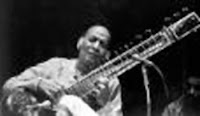The post-independence era is now acknowledged as the Golden Age of instrumental music in the Hindustani tradition. A large part of the credit for this goes to the Sitar and to sitarists. The instrument entered the mainstream as an heir to the medieval Rudra Veena to later become its rival, and finally, its survivor. Its journey to the pinnacle of Hindustani instrumental music has taken about 300 years.
The emergence of the Sitar has long been attributed to the 13th century. Latest researches however establish the instrument as a recent development. The first reference to the Sitar [1739] names a Khusro Khan, who was an expert Sitar player, and, most likely, a brother of the legendary musician, Niamat Khan [Sadarang] in the court of Emperor Mohammad Shah “Rangile” [1719-1748]. Apparently, this Khusro Khan spent some years in Kashmir, acquainted himself with the Kashmiri Sehtar, and brought it to Delhi.
Until its arrival at the Delhi Court in the early 18th century, the Sitar was an unrefined melodic instrument, evidently used in orchestration supporting singing and dance performances. Its use may have been restricted to a strumming role akin to that of a banjo. Though this continued into the 19th century, the Sitar had, by then, also emerged as solo instrument capable of executing well-defined melodic passages.
By the late 19th century, the sitar had become a phenomenon, attracting a large number of professional and amateur musicians in various part of the country, and acquiring a place in the Courts of princes. The instrument had assumed most of the physical features and tuning systems of the modern sitar, though not its present day acoustic sophistication or melodic capability. It had developed an idiom of its own, inspired initially by the Rudra Veena, but responding constantly to changing aesthetic values.
These developments were obviously accompanied by changes in the design and construction of the instrument – a process that has continued in later years as musicians have wanted the instrument to deliver music of progressively greater sophistication, and to offer a wider variety of stylistic options.
Stylistic lineages of Sitar music
The notion of a gharana is not as well defined in Sitar music as it is, say, in Khayal vocalism. However, distinctive stylistic lineages – called “Baj” – identified in 1990 at the ITC-SRA Seminar on the Sitar are a good indicator of the various claims to stylistic distinctiveness.
 |
| RAVI SHANKAR |
 |
| VILAYAT KHAN |
(c) The Jaipur Beenkar/ Sitar gharana. The nomenclature refers to a lineage of Rudra Veena players from Jaipur, who evolved and propagated a Rudra Veena-biased style of sitar playing. The last significant performer in this tradition was Bimal Mukherjee [1930-1996].
(d) The Bishnupur gharana. This nomenclature refers to the town of Bishnupur in Bengal, which emerged as a major centre of music in the latter half of the 19th century. At the turn of the 20th century, the most distinguished exponent of this lineage is Pandit Manilal Nag.
 |
| HALIM JAFFAR KHAN |
 |
| MUSHTAQUE ALI KHAN |
(f) The Senia gharana: The nomenclature refers to the descendants of the legendary Mian Tansen, who call themselves “Senia-s”. Of the various Senia streams of sitar music, the only one active at the turn of the century was the one hailing from Benares. The last significant performer of this style was Ustad Mushtaque Ali Khan. His important contemporary disciples are Debabrata Choudhary and Netai Bose.
(g) The Lucknow gharana: The gharana, also called the Lucknow- Shahjehanpur gharana, is essentially a lineage of Sarod players. But, it has also produced distinguished Sitar players such as Ilyas Khan [1924-1989], Waliullah Khan [1890-1951] and Yusuf Ali Khan [1877-1962]. By the end of the 20th century, the gharana reported no significant musicianship.
Sitar styles today
Amongst the major instruments, the Sitar has been singularly fortunate in producing two giants in the same generation – Ustad Vilayat Khan [Etawah] and Pandit Ravi Shankar [Maihar] -- who created entirely distinctive musical worlds around themselves. Though seven Gharana-s of Sitar music were identified as recently as 1990, several of them are already devoid of a significant presence on the concert platform.
The future of stylistic diversity seems in question. The strength of homogenising forces is already evident in the fact that the Vilayat Khan style is proliferating much faster amongst professional sitarists than the Ravi Shankar style. The cultural environment, too, is not particularly conducive to the flowering of sharply differentiated styles.
Musical attitudes and stylistic tendencies are no longer acquired either exclusively, or even predominantly, through the traditional system of personalised apprenticeship and aesthetic indoctrination. Low cost access to recorded music has demolished all barriers to the acquisition of musical skills and practices. A market of sub-continental, and even global, dimensions appears to reward music conforming to the dominant models. As a result, Sitar music of the foreseeable future could be stylistically less – rather than more – diverse than Sitar music of the present.
For a comprehensive discussion on the Sitar and eight other major instruments, refer to the author’s book: Hindustani Music Today DK Printworld Pvt. Ltd. New Delhi. 2011.
No comments:
New comments are not allowed.